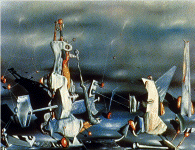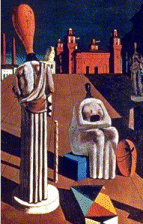
 Mysticism
Mysticism

 Mysticism
Mysticism
by Robert S. Robbins
Mysticism is a well-documented cognitive state. Every religion has its mystics and there are remarkable similarities in the various descriptions of mystical experiences. In fact, it is unreasonable to doubt the existence of transcendent consciousness because drug experimentation can artificially induce such ecstatic mental states. The creative artist has often led the way in exploring the irrational mind through the exploration of Eastern religions, drug experimentation, psychology, and intoxication. Virtually every writer, poet, artist, and musician has shown intense curiosity in the subject. Their curiosity is motivated by a search for inspiration or a stimulus to the imagination. Artists have tried everything from Zen to peyote to unlock the secrets of the soul. Much of this article will be based upon the book Understanding Mysticism by Richard Woods, ISBN 0-385-15117-9. The book is a collection of essays on mysticism by such experts in the field as Evelyn Underhill, William Ernest Hocking, Henri Bergson, William James, and W.H. Auden. Various intellectual disciplines are represented in the text including comparative religion, philosophy, psychology, theology, science, and aesthetic evaluations. All quotes will be from this book.
 A mystical experience is always interpreted through the
religious framework of the mysticís culture. The major religions all have
corresponding mystical traditions: Jews - Kabbalah, Buddhists - Zen, Hindus
- Rig Veda, Islam - Sufi, Christians - divine union with God, and American
Indians - nature mysticism. I prefer to interpret mystical experiences
through the framework of art and culture and therefore I will speak of the
sublime and place a greater emphasis on visions than the feeling of oneness
with the universe. Most mystics attach greater importance to this escape
from the self into a union with the universe or God but I consider visions,
miracles of the imagination, to be of greater interest to the artist. When
the conscious mind with its tiresome thoughts has been surpassed, and
consciousness transcends the ego, it is possible to either experience the
subconscious or a complete loss of self. A mystic prefers the complete loss
of self for its serenity and rapture but a visionary state is more rich in
imagery and can possibly reveal more mysteries of the soul.
pg 457
"As for the
imagination, many spiritual writers attribute a new function to it in the
visions and voices which usually precede the higher states of union.
Imaginary visions may appear with the intensity of actual sensations, yet
without any hallucinatory sensory experiences and often in fantastic or
unprecedented forms. It is as if images and symbols normally restricted to
the unconscious are released when the mind first penetrates into the unknown
depths of itself."
A mystical experience is always interpreted through the
religious framework of the mysticís culture. The major religions all have
corresponding mystical traditions: Jews - Kabbalah, Buddhists - Zen, Hindus
- Rig Veda, Islam - Sufi, Christians - divine union with God, and American
Indians - nature mysticism. I prefer to interpret mystical experiences
through the framework of art and culture and therefore I will speak of the
sublime and place a greater emphasis on visions than the feeling of oneness
with the universe. Most mystics attach greater importance to this escape
from the self into a union with the universe or God but I consider visions,
miracles of the imagination, to be of greater interest to the artist. When
the conscious mind with its tiresome thoughts has been surpassed, and
consciousness transcends the ego, it is possible to either experience the
subconscious or a complete loss of self. A mystic prefers the complete loss
of self for its serenity and rapture but a visionary state is more rich in
imagery and can possibly reveal more mysteries of the soul.
pg 457
"As for the
imagination, many spiritual writers attribute a new function to it in the
visions and voices which usually precede the higher states of union.
Imaginary visions may appear with the intensity of actual sensations, yet
without any hallucinatory sensory experiences and often in fantastic or
unprecedented forms. It is as if images and symbols normally restricted to
the unconscious are released when the mind first penetrates into the unknown
depths of itself."
Mystics often achieve their state of heightened perception through religious rites, meditation, or rituals. In Christianity this is known as the Mystic Way which consists of three stages. First there is purgation, a period of asceticism to deny the desires of the self. Then there is a period of rapture during which the mystic apprehends the infinite and eternal. Finally, the mystic achieves the height of human consciousness, the divine union with God. There can be an intermediate stage involving the loss of ecstasy and a period of despair known as the Dark Night Of The Soul. Eastern religions demand a lengthy period of disciplined meditation before enlightenment or nirvana can be achieved. I would speculate that these mental exercises and preparations are only necessary when the individual has a particularly hard time freeing himself from his identity and patterns of thought. I find it much easier to slip into a deeper cognitive state. It is especially easy to achieve these heightened states of perception at night when the streets are deserted and artificial lights replace the harsh light of day. The desolation makes it easy to escape the self-consciousness created by society and the artificial lights seem to bathe a scene in mysterious significance, a new illumination.
|
The Four States Of Heightened Consciousness |
|||
| State | Description | Method | Focus |
| Meditative | Serenity. Contemplative. Emotional detachment. Greater objectivity and mental clarity. Peaceful. | Meditation | Mind |
| Visionary | Contemplation of mental imagery without emotional engagement. Serene dreams. | Imaginative Meditation | Dream |
| Awakened Dreams | Dreams are now fully engaged in by the emotions. The dream lives in the mind and haunts the soul. Metaphysical nightmare. | Sleep Deprivation | Nightmare |
| Total Shock | Rush of adrenaline. Shock and awe. A state of powerfully altered perception begins. The mind is stunned. | Psychoactive Drugs | God |
What does the artist have to gain from mystical experiences? For one thing, it can free him from the limitations of conscious invention and offer him miracles of the imagination. I use the word miracle in part to suggest the interesting phenomenon of images or ideas occurring to the mind by magic instead of through an identifiable series of thoughts. Miracles of the imagination is also an apt phrase because these visions are often far beyond anything that you would think yourself capable of imagining. They are strange to the conscious mind because they come from a depth of the soul which it is completely unfamiliar with. Such visions can even be more extraordinary than dreams that come in sleep. pg 409 "They are not produced by any voluntary process of composition, but loom up, as do the best creations of other artists, from his deeper mind, bringing with them an intense conviction of reality." "I believe that we may look on such visions as allied to dream-states; but in the case of the great mystics they are the richly significant waking-dreams of creative genius, not the confused and meaningless dreaming of normal men."
 Mystics frequently
claim their experiences are ineffable. Words cannot describe the visions and
ecstasy which accompany the transcendent consciousness. This inability to
communicate purely spiritual perception to the conscious mind is a vexing
problem for the artist. The best that can be hoped for is evocative language
which may suggest something of the experience to the rare individual who is
familiar with such experiences himself. The problem lies in the fact that
transcendent revelations were not arrived at by conscious invention or a
logical progression of thoughts and they cannot be reproduced by any
intellectual or creative process. Language is the currency of the rational
mind. As is well known, the subconscious mind uses symbols and imagery in
dreams because it is a level of consciousness that has no access to
language. Another problem the artist can encounter is the loss of desire to
communicate his profound insights. When self-consciousness has fallen away
and there is no longer an identity except for an identity in the universe
then there is no need to communicate any more. Such a mental state does not
even allow for the existence of "the other". It is quite possible that there
have been unknown great souls who have enjoyed the most extraordinary
visions without attempting to share their experiences because they have felt
no desire to speak of it or felt incapable of communicating it to others.
Mystics frequently
claim their experiences are ineffable. Words cannot describe the visions and
ecstasy which accompany the transcendent consciousness. This inability to
communicate purely spiritual perception to the conscious mind is a vexing
problem for the artist. The best that can be hoped for is evocative language
which may suggest something of the experience to the rare individual who is
familiar with such experiences himself. The problem lies in the fact that
transcendent revelations were not arrived at by conscious invention or a
logical progression of thoughts and they cannot be reproduced by any
intellectual or creative process. Language is the currency of the rational
mind. As is well known, the subconscious mind uses symbols and imagery in
dreams because it is a level of consciousness that has no access to
language. Another problem the artist can encounter is the loss of desire to
communicate his profound insights. When self-consciousness has fallen away
and there is no longer an identity except for an identity in the universe
then there is no need to communicate any more. Such a mental state does not
even allow for the existence of "the other". It is quite possible that there
have been unknown great souls who have enjoyed the most extraordinary
visions without attempting to share their experiences because they have felt
no desire to speak of it or felt incapable of communicating it to others.
A mystical experience is sometimes described as the lifting of a veil from reality. pg 401 "Between nature and ourselves - more, between ourselves and our own consciousness - hangs a veil: a veil dense and opaque for normal men, but thin, almost transparent, for the artist and poet." The world we know is considered to be dimly perceived by the conscious mind while the transcendent consciousness is a true revelation of reality as it really exists. While I donít believe in a higher reality I have experienced an intuitive comprehension of the essence of things. pg 21 "It is a spiritual sense opening inwardly, as the physical senses open outwardly, and because it has the capacity to perceive, grasp and know the truth at first hand, independent of all external sources of information, we call it intuition." When all consciousness of the self is lost it is possible to completely lose oneself in everything else. Just as you can feel a union with the universe, you can feel the essence of a place or everyday object. It is difficult to adequately explain this phenomenon but I suspect the direct apprehension of the essential and absolute reality is made possible by the absence of the subjective self. Once the subjective world is gone the mind confuses itself with the objective and knows itself as the objective world, direct consciousness of reality.
Although the subject of mysticism has led me to use many religious terms, I do not consider my intimacy with the sublime to have any religious significance. I have always preferred to think of my visions as being evidence of an artistic nature. Many accounts of mystical experiences can be found in literature and I have always recognized these fumbling attempts to convey a mysterious deepening of perception. Since poets have made a practice of speaking of such things and dealing with these concepts I have been more inclined to think of myself as a true poetic soul than a mystic. It is somewhat disquieting to think of ecstatic reverie in terms of metaphysical extremes (the infinite, the eternal, or the transcendent) and far more pleasant to accept the sublime as an intense aesthetic experience.

